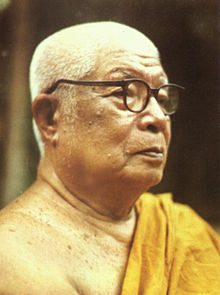The provinces of Thailand are administrative divisions of the government of Thailand. The country is divided into 76 provinces proper, with one additional special administrative area. They are the primary local government units and act as juristic persons. They are divided into amphoe (districts) which are further divided into tambon, the next lower level of local government.

Monthon were administrative subdivisions of Thailand at the beginning of the 20th century. The Thai word monthon is a translation of the word mandala, in its sense of a type of political formation. The monthon were created as a part of the Thesaphiban bureaucratic administrative system, introduced by Prince Damrong Rajanubhab which, together with the monthon, established step-by-step today's present provinces (changwat), districts (amphoe), and communes (tambon) throughout Thailand. Each monthon was led by a royal commissioner called Thesaphiban (เทศาภิบาล), later renamed to Samuhathesaphiban (สมุหเทศาภิบาล). The system was officially adopted by the 1897 Local Administration Act, after some monthon had been established and administrative details were sorted out.

Chaiya is a former capital district of Surat Thani province, Southern Thailand. The main town is Talat Chaiya.
Public holidays in Thailand are regulated by the government, and most are observed by both the public and private sectors. There are usually nineteen public holidays in a year, but more may be declared by the cabinet. Other observances, both official and non-official, local and international, are observed to varying degrees throughout the country.

Prince Tisavarakumarn, the Prince Damrong Rajanubhab was the founder of the modern Thai educational system as well as the modern provincial administration. He was an autodidact, a (self-taught) historian, and one of the most influential Thai intellectuals of his time.

Thai art refers to a diverse range of art forms created in Thailand from prehistoric times to the present day, including architecture, sculpture, painting, textiles, decorative arts, crafts, ceramics, and more. While Buddhism has played a significant role in Thai art, with many sculptures and paintings depicting Buddha images and religious themes, nature, including flora and fauna, as well as mythical creatures, has been a major inspiration for Thai art, with colorful motifs appearing in various types of art forms. In contemporary Thai art, traditional works remain significant and continue to influence artists' concepts.

Mueang Nonthaburi is the capital district of Nonthaburi province in Thailand. The city of Nonthaburi has 267,001 inhabitants, while the whole district has 348,553.
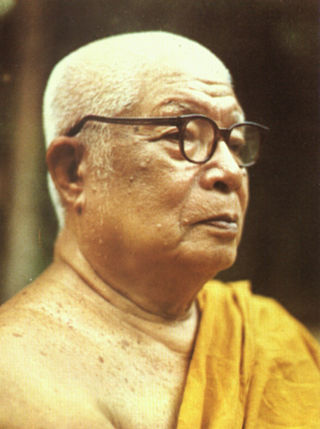
Buddhadasa was a Thai Buddhist monk. Known as an innovative reinterpreter of Buddhist doctrine and Thai folk beliefs, he fostered a reformation in conventional religious perceptions in his home country, Thailand, as well as abroad. He developed a personal view that those who have penetrated the essential nature of religions consider "all religions to be inwardly the same", while those who have the highest understanding of dhamma feel "there is no religion".
Si Votha was a Cambodian prince who was briefly a contender for the throne. He spent his entire life fighting his half brother King Norodom for the throne.

Monthon Surat was an administrative subdivision of Thailand in the early 20th century. It covered the northeastern part of southern Thailand, including the present-day provinces of Surat Thani and Chumphon.

P. A. Payutto, also known by his current monastic title, Somdet Phra Buddhaghosacariya, is a well-known Thai Buddhist monk, an intellectual, and a prolific writer.

The King Narai's Palace in Lopburi was built by King Narai the Great, the king who ruled Ayutthaya from 1656 to 1688. He ordered the palace built in 1666 in the same area as King Ramesuan's Palace. King Narai stayed here for about 8–9 months a year, except during the rainy season. He designated Lopburi as the second capital of the Ayutthaya Kingdom. The palace was a place for relaxation, hunting, administering the country's affairs, and welcoming official visitors. When the king died in 1688, Lopburi and the palace were abandoned.
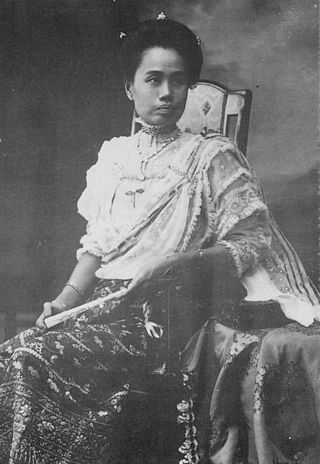
Dara Rasami, was a princess of Chiang Mai and Siam and the daughter of King Inthawichayanon of Chiang Mai and Queen Thip Keson of Chiang Mai descended from the Chet Ton Dynasty. She was one of the princess consorts of Chulalongkorn, King Rama V of Siam and gave birth to one daughter by King Chulalongkorn, Princess Vimolnaka Nabisi.

Wachirabenchathat Park, or often spelled Vachirabenjatas Park, also popularly known as State Railway Public Park is a name of public park in Chatuchak district, Bangkok, Thailand. The park borders on the Queen Sirikit Park and Chatuchak Park, and it is also the largest park of the complex, bounded by Kamphaeng Phet 3 road and Kamphaeng Phet 2 road with Soi Nikhom Rotfai Sai 1 near PTT Head Office and Ministry of Energy. It is one of the most popular parks in Bangkok.

Chak Phra is a Buddhist festival that is celebrated annually in Southern Thailand and Northern Malaysia. The name "Chak Phra" could be translated as “Pulling the Buddha”, “pulling of the Buddhist monks”, or “pulling of ceremonial Buddha image carriages”.

His Highness Prince Suphayok Kasem, formerly known as: Mom Chao Nen Kashemsri, was a son of Prince Kashemsri Subhayok and Mom Poem Kashemsri na Ayudhya, and a former Thai Minister of Finance.
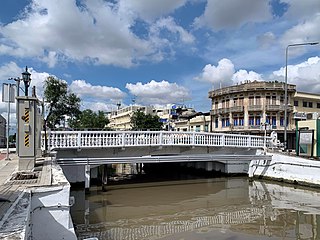
Chang Rong Si Bridge is a bridge and monument in the Rattanakosin Island area at a tripoint between Phra Borom Maha Ratchawang and San Chaopho Suea with Wat Ratchabophit Subdistricts of Phra Nakhon District, the historic centre of Bangkok. The bridge spans Khlong Khu Mueang Doem, the old city moat, and is locate behind the Ministry of Defense and at the front corner of the Ministry of Interior. It signifies the beginning of Bamrung Mueang Road as it continues eastward from Kanlayana Maitri Road. Atsadang Road meets the bridge's eastern foot at the eponymous Saphan Chang Rong Si Intersection, while Rachini Road runs alongside the canal on the opposite side.
Chaophraya Phitsanulok, personal name Rueang or Boonrueang, was governor of Phitsanulok city with the noble title Chaophraya Surasi Bisanuvadhiraj, from 1732 to 1767. He was governor during the reign of King Borommakot, until the fall of the Ayutthaya Kingdom during the reign of King Ekkathat. In 1768, he proclaimed himself King Rueang of Phitsanulok, and declared Phitsanulok and part of Nakhon Sawan a new independent stat. or Prince Rueang, the King of Siam. His descendants were bestowed the Thai noble surname Rochanakul, a patronymic from Rueang’s family, by King Rama VI.
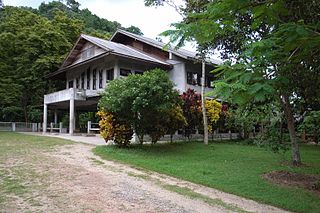
Suan Mokkhaphalaram, known as Suan Mokkh for short, is a Theravada-Buddhism monastery, retreat and meditation center in Amphoe Chaiya, Surat Thani, Thailand. It was founded in 1932 by the well-known monk, religious and social reformer Buddhadasa Bhikkhu, who was a representative and pioneer of Engaged Buddhism.



